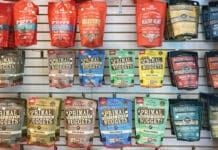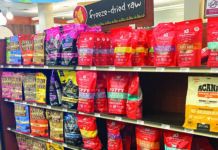[Updated March 22, 2018]
We haven’t reviewed dehydrated diets for quite some time – long enough that there have been quite a few additions to the pool of companies who make and sell this type of dog food. It’s increasingly popular, for a lot of reasons.
For one thing, “raw diets” are increasingly popular, too, and most of the products in this category incorporate raw animal proteins in their formulations. People who believe in the superiority of canine diets that include raw meat (often referred to as biologically appropriate or evolutionary diets) can use a dehydrated or freeze-dried food as a convenient replacement for their dogs’ fresh, home-prepared or commercial frozen raw diet. This is especially helpful when traveling with a raw-fed dog, or when the dog is left with a sitter who doesn’t want to deal with raw meat in its wet, bloody form. (One maker of dehydrated diets, ZiwiPeak, describes its products as “raw without the thaw.”)
When it’s dehydrated or freeze-dried, raw meat doesn’t seem so, well, raw. Most of us don’t think of beef jerky as raw meat, either, but it actually is. The drying process (and, in jerky, the use of salt and nitrates) “cures” the meat, altering its appearance and texture and concentrating its flavor – and, significantly, halting the biological action (decay) in the food – with less damage to the meat’s natural enzymes or vitamins than cooking temperatures would cause.
All the ingredients in canned food are cooked in the can. Some ingredients in kibble are actually cooked twice; meat “meals,” for example, are first subjected to rendering (essentially boiling, drying, and then grinding) and then extrusion (pushed through a tube under high pressure and subjected to a short blast of high-temperature steam) and drying. Plainly, the proteins in the meat ingredients are still nutritious after being extruded, but, raw food proponents allege, not nearly as healthful for canines as they were in their raw form.
Most of the other ingredients in freeze-dried or dehydrated foods are raw, too. Plus, they are very lightly processed, in comparison to the ingredients in other types of dog foods.
Raw diets aren’t for every dog or owner. Cooked foods may be safer for immune-compromised individuals. Some dogs digest cooked foods better.
Note: At least one maker of dehydrated foods (NRG USA) uses cooked meats in some of its products.
Benefits of Feeding Dehydrated Dog Food
In addition to being raw and lightly processed, dehydrated diets offer a number of other benefits to dogs – and their owners.
1. Dehydrated dog food won’t go bad (for a while).
Very low-moisture foods can be stored longer at room temperature (in unopened packages) without spoiling or rancidity than conventional kibble. Most dehydrated diets contain less moisture than conventional kibble, which generally contains about 10 percent moisture. The less moisture there is in a food, the less biological activity can occur.
2. Dehydrated food is lighter and more portable.
Dehydrated foods weigh less and are more compact than foods containing more moisture. This makes them especially well suited for travel. It also means they cost less to ship!
3. Raw dehydrated/freeze-dried food tastes amazing to dogs.
When rehydrated, these foods are highly palatable to most dogs. It may be due to the concentration of flavor in dehydrated food ingredients or their light processing. Dogs with poor appetites (like very senior or chronically ill dogs) may accept these foods when nothing else appeals.
4. Top-quality ingredients are the rule, not the exception, in dehydrated dog food.
As a generalization, the makers of these products are targeting the top end of the market, and have an extraordinary commitment to sourcing top-quality ingredients; in some cases, “human-quality” (“edible”) ingredients are used (though this claim can be made and verified by only one dehydrated dog food manufacturer: The Honest Kitchen).
The Different Categories of Dehydrated Dog Food
The dehydrated foods on the market are diverse in content, appearance, and form. Some contain grains and some don’t. Some are very high in protein and fat, and some compare in these respects to conventional kibble. Always check the “guaranteed analysis” when switching to a product in this category; they are so nutrient-dense that you may have to significantly reduce the volume of food that you feed your dog.
Most of these products are meant to be rehydrated with water before serving, although one (ZiwiPeak) contains a higher amount of moisture than kibble, and is fed without rehydration. One (DNA) comes in a cubed form, and reabsorbs a relatively small amount of water. Some are very powdery, which makes them turn into a sort of mush (or gruel, depending on how much water you add) when rehydrated. Some are powdery with large chunks of identifiable dehydrated meats, fruit, and/or vegetables – either an advantage (if your dog enjoys the contrast in taste and mouth-feel) or a disadvantage (if your dog seeks out only the chunks or mush and eschews the other). The products that come in dried “burger” or “medallion” form reconstitute in a form that most resembles an actual ground meat patty.
If you read the descriptions of each product, note that some contain “air-dried” or “dehydrated” (same thing) or freeze-dried ingredients. The difference in nutritional content of foods processed in either manner is negligible. However, dehydration alters the cellular structure of meats, fruits, and vegetables more radically altering their appearance and taste than freeze-drying. Rehydrated, freeze-dried ingredients taste remarkably similar to their fresh, moist counterparts. Does this matter to your dog? You’d have to try different products to find out. Note that the freeze-drying process requires higher-tech, more expensive machines, making the cost of foods that contain freeze-dried ingredients quite a bit higher.
Because the cost of these products is so high, we’d imagine that few people feed them full-time, especially if their dog or dogs are large. I calculated the cost of feeding some of these products to my 70-pound, active dog at more than $200 a month – more than what it would cost to feed a home-prepared diet. Personally, I’d most likely use them only for a small dog, or on a short-term basis while traveling, as a special treat, to jump-start a sick dog’s recovery, or to extend the life of a chronically ill dog.
“Human-Quality” Dog Food Ingredients
As we’ve discussed many times in WDJ, there is only one way that a company can legally claim that its dog food contains ingredients that are “human quality” (the legal term is “edible,” though of course regulators mean only “human edible” in this context): If it is made in a manufacturing facility that contains only edible ingredients. The presence of a single “inedible” ingredient in a manufacturing facility, by law, would re-classify every ingredient and product present at that location as “pet food.” By law, you can take a refrigerated truckload of the world’s finest, freshest, cleanest filet mignon to a facility that makes pet food, but the second the truck drives onto the facility’s property (or the moment the truck’s door is opened, accounts vary), none of that meat can be called edible or human-quality again.
This is frustrating to the pet food makers who genuinely use ingredients of that quality, and to consumers who want proof – a certain way to verify – the true quality and provenance of the ingredients in their dog’s very expensive food. But unless a food company wants to use only edible ingredients, and have its products made in a facility that uses only edible ingredients, jump through a million bureaucratic hoops to demonstrate completion of these requirements to the regulators in every single state – and price its products accordingly – it can’t say it uses “human-quality” ingredients. Only one company that we know of (the Honest Kitchen) can make this legal claim for its products, which are made in a human food manufacturing facility in Illinois (which also makes human soup mixes and other human foods that contain dehydrated human food ingredients).
Pet food makers who do use “edible” meats and other ingredients in their products sometimes resort to using code words to give consumers a hint about their ingredient quality. They have to be subtle, though, because if they are too overt, state feed control officials can hit them with a warning, fine, and/or stop-sale order.
Here’s the problem with that approach: Because it’s illegal, it’s not verifiable! And because it can’t be confirmed (say, by checking the manufacturer’s registration as a human food manufacturing facility), any company can slyly hint about their alleged “human-quality” ingredients, whether they really use them or not.
If ingredient quality is critical to you – if you insist on and are willing to pay for foods that contain only “edible” ingredients, your only sure options are to home-prepare your dog’s food with ingredients you buy from human food sources, or to buy products from The Honest Kitchen.
Alternatively, you can engage in conversation with representatives of pet food companies who make what appear to be (based on their ingredients lists) very high-quality foods, and ask them about the provenance of their ingredients. If they claim (or hint) that some of their ingredients are “human-grade,” “just like the ones you buy in the supermarket,” “USDA,” or some other code-phrase, ask them to discuss this further – and do a gut-check on their reply. It’s all you’ll really have to go on.
Nancy Kerns is Editor of WDJ.






